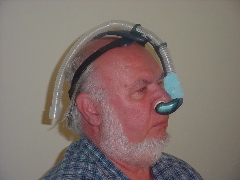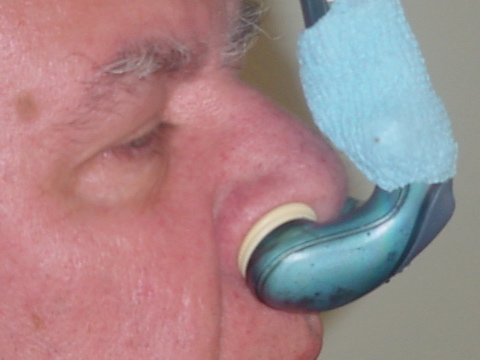Living With Sleep Apnea
It all started in late 1995. My wife, Dee, and I were invited to a Christmas
dinner at a friend's house. Other couples we didn't know were also invited. We
met Joe and Gina, and noticed that Joe showed all the signs of recovering from a
stroke. We asked Gina what had happened to Joe, and she confirmed our
suspicions. Dee asked Gina, "Do you know what caused the stoke?" Gina said they
weren't sure, but they suspected it was caused by Joe's sleep apnea, a condition
he was diagnosed with after having had the stroke. We were not sure what sleep
apnea was, so Dee asked Gina to describe it. She said, "You're snoring, then
you stop snoring and stop breathing, there's a long pause, and then you snort
and gasp for breath. The cycle then repeats." Dee then said, "Dick does that."
Gina, in a stern voice said, "You get him tested, and do it soon. You don't
want him ending up like my Joe."
The next week, I called my doctor, told him what I suspected, and he arranged
for me to take a sleep test. This was a simple procedure where I took home a
Pulse- Oximeter to measure my pulse and oxygen level in my blood as I slept.
The device had a clothes-pin type of connector that I attached to one of my
fingers. During the night, the machine recorded my pulse and blood oxygen
level. The next day, I brought the device back to the clinic. I expected to
hear the results the next day.
Two weeks passed, and no word about my sleep test. I began to assume there was
nothing wrong. Then, I got a metal sliver in my eye, and had to go to the
Emergency Room to have it removed. The doctor who treated me had my chart, and
remarked, "It looks like you had a sleep study recently. You better contact
your regular doctor immediately, this doesn't look good." He couldn't tell me
more, but as soon as I got home I called my regular doctor. The nurse answered,
and I found out my doctor had been away on vacation, and had just returned that
day. I told her what happened, and she said she would inform the doctor.
A few hours later, I received a call from my doctor. He had arranged for me to
pick up a CPAP machine from the sleep clinic. I went to get the CPAP machine
immediately. They also gave me the Pulse-Oximeter again to test myself after
getting comfortable with the CPAP machine. It was Friday, so the earliest I
could return the test results would be the next Monday. I slept with the
machine Friday and Saturday nights without connecting the test device. Sunday,
I tested myself, and brought the results back to the clinic Monday morning.
They compared my first test with the new test. In the first test, as I fell
asleep, my heart rate would slow down slightly. My oxygen level was at about
90%. Then, you could see my heart rate rise to 120, and my oxygen level fall to
50%. Then a spike, as my oxygen level would shoot up to about 90%, and my heart
rate would begin to decrease to about 110. But then the heart rate would start
to rise again, and my oxygen level would fall to 50% again. Another "episode"
of sleep apnea occurred. I had over 200 episodes in less than 8 hours.
The new test showed a dramatic improvement. My heart rate stayed low and steady
all night long, and my oxygen level stayed at 90% or higher. The CPAP machine
was doing its job. I returned home feeling very good. I noticed during these
first few nights that I slept like a rock. I didn't move all night long. I was
so tired from sleep apnea episodes that my body took this opportunity to
"recover" and "rest".
I thought my problems were over, but I was wrong. After a week, I noticed a cut
on the bridge of my nose caused by the CPAP mask pressing against it. The cut
was becoming infected and looked green. I called the clinic and told them what
was happening. I had to bring back the mask I was using and try another mask.
This one had soft plastic all around the opening that covered my nose. The mask
pressed against my face differently, and was more comfortable. I tried that for
a week.
I noticed the skin around my nose was breaking out in a rash. I called the
clinic again, and brought this mask back. I was allergic to the plastic! What
could be done? The therapist suggested I try "pillows", nasal plugs that supply
the needed pressure directly into my nose. Nothing touches your face or the
bridge of the nose. I didn't think that would work, but was willing to give it
a try.
What a difference! This solved most of my problems. And it had several
advantages the masks didn't have. The hose which feeds the air comes over the
top of your head, instead of across your chest. My hands were free. And there
was no "leakage", no air blowing into my eyes, as was the case with the masks.
And I could turn over on my side and sleep with the side of my face on the bed
pillow. I couldn't do that with the masks because they would get knocked loose
from my face, or the hose would get entangled.
There were a few problems with the nasal "pillows". I had to alter the head
gear slightly by running a strap across the top and down to the sides. This
kept the support in position under my nose. I added home-made tube socks around
the hose joints to prevent small leaks from escaping. And I had to add an
additional 45- degree angle joint between the hose and the support. This placed
the support directly against my upper lip, and let the "pillows" slide directly
up into my nose. Without this joint, the "pillows" came in at an angle, and
could also leak slightly.
Adding the 45-degree joint presented a new problem. The "blow hole" in the
support now pointed down at my chest. That blowing air gets cold! So I blocked
off the blow hole and drilled another near the new joint. Now the air blew
straight away from me. Lastly, the air flowing through the hole across the top
of my head was making the hose cold. I added a golf cap, with the brim taken
off, inside the webbing. This solved two problems. It eliminated contact with
the cold hose, and made it easier to place the apparatus on my head. Now I had
"what works for me".
After a few months, I began to notice something. Prior to getting the CPAP
machine, I'd frequently wake up in the middle of the night with food in my
throat. I thought I might have Acid Reflux disease. I tried antacids, but they
didn't help. Then I started on CPAP. The Acid Reflux disappeared! I've since
come to believe that when I stopped breathing, I put reverse pressure on my
esophagus, which resulted in the drawing of food up from my stomach. Maybe the
symptoms of Acid Reflux are also symptoms of Sleep Apnea. I can't prove it, but
I haven't had an episode of food regurgitation since I started CPAP many years
ago. If you are taking pills to control Acid Reflus, and you are now using CPAP,
then I suggest you stop taking the Acid Reflus medication, and see what happens.
You may discover, like I did, that CPAP eliminates Acid Reflux. If not, go back
to using your medication. You've got nothing to lose by giving it a try.
I joined a support group, called AWAKE, and learned about other options besides
CPAP (Continuous Positive Airway Pressure). Diet and exercise often helps
overweight people. Others try surgery. However, surgery doesn't have a high
success rate. Usually only one in four or five are successful. One of my
friends had a very bad experience with surgery. Not only did it fail, it left
his jaw such that it would open as he slept. Now the standard masks and nasal
pillows wouldn't work because he could not maintain pressure. He was forced to
use a full-face mask.
Another friend of mine was fitted with nasal pillows, but with the wrong size.
Instead of the clear or cream colored pillows designed for large nostrils, he
was given the blue pillows designed for small nostrils. The cone went up into
his nose, and was very uncomfortable. The correct size pillows should seal
against the end of your nose, not stick up into the nose.
If you suffer from the symptoms of sleep apnea, I urge you to get tested to see
if you need CPAP. And if you do, get what works for you. If the respiratory
therapist gives you something that doesn't work for you, ask to try
alternatives. Technicians or therapists can make mistakes. Remember, it is
YOUR life. Sleep well.
Dick Guertin
Mountain View, CA
For more information about sleep apnea, visit the





